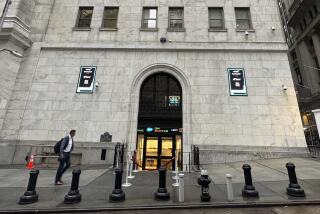Wall Street Rallies on Forecasts
Stocks rebounded with a vengeance Thursday, lifting the Dow index 206 points for its biggest gain in two years on the strength of strong profit outlooks from a diverse mix of companies.
The upbeat forecasts from United Parcel Service, Marriott International, Nokia and others helped calm the economic worries that had sparked recent sell-offs -- at least for a day.
The Dow had fallen in five of the previous six sessions, sliding a combined 495 points and nearly slipping below 10,000 on Wednesday amid signs that higher energy costs were triggering price increases across the economy.
But a growing wave of robust corporate profits put Wall Street back in a buying mood. Bargain hunting also fueled the upswing, analysts said, as investors bet that many stocks had hit bottom for the near-term.
Experts cautioned that the marketâs up-and-down volatility could continue as long as mixed signals about the economy kept surfacing.
âThe market is a little schizophrenic these days,â said Liz Ann Sonders, chief investment strategist at Charles Schwab & Co. in New York. Sonders said Wednesdayâs slide was a reaction to economic data showing a whiff of inflation.
On Thursday, âPeople realized that earnings are just as important to the economic landscape,â Sonders said. âAlthough profit growth is decelerating, itâs not doing so as fast as the bears had thought.â
The Dow Jones industrial average zoomed 206.24 points, or 2.1%, to 10,218.60. The broader Standard & Poorâs 500 index soared 22.45 points, or 2%, to 1,159.95. The technology-heavy Nasdaq composite index fared even better, soaring 48.65 points, or 2.5%, to 1,962.41.
The Dow and the S&P; 500 notched their biggest one-day percentage gains since October 2003. The Dow scored its best point gain since April 2, 2003, when it climbed 215 points.
Bond prices slumped as traders returned to equities. The yield on the benchmark 10-year T-note rose to 4.30% from 4.19% on Wednesday. Bond yields increase as their prices decline.
Oil traded slightly higher, with a new crude futures contract rising 17 cents to $54.20 in New York.
The stock marketâs recent slide began last week, with a report suggesting that high energy costs were cutting into retail sales. Market indexes were mixed Monday and rallied Tuesday, but on Wednesday a report of higher-than-expected inflation last month sent the Dow into a 115-point tailspin on the specter of sharp interest rate hikes by the Federal Reserve.
Late Wednesday and on Thursday, however, companies across many sectors including technology and manufacturing raised their earnings outlooks.
In the tech sector, Nokia and rival Motorola both topped expectations for the first quarter and boosted profit targets for the current quarter. Nokia rallied $1.01 to $16.35 and Motorola climbed $1 to $15.93.
UPS, attributing its strong quarterly profit partly to a boom in shipments from Asia, boosted earnings projections modestly for the full year. The stock rose $3.30 to $70.56.
Hotel chain Marriott also topped expectations and guided analysts higher for the rest of 2005, citing heavy bookings. Marriott shares rose $1.17 to $63.37.
Manufacturer Ingersoll-Rand posted solid numbers on the strength of higher prices for its construction equipment. The stock gained $1.65 to $80.46.
Among S&P; 500 companies, profits are expected to grow an average of 12.7% this year, said research director Nick Raich at Zacks Investment Research in Chicago. Those projections were up slightly from a week ago.
âIâm a little surprised companies are raising [earnings] guidance in light of these high oil prices and the fears of âstagflation,â â he said, referring to the risk of stagnant economic growth and rising inflation.
Analysts cited âtechnicalâ factors as well. Bearishness had gotten so extreme that the market was due for at least a temporary bounce, Sonders said. Recent investor surveys have recorded high levels of bearishness. âOdd-lot short-selling,â a measure of bearish bets by small investors, hit a record Friday, Sonders said, when the Dow fell 190 points.
Analysts look at such sentiment readings as contrarian indicators: When bearishness or bullishness gets extreme, the market often turns course because the pessimists or optimists have exhausted their activity for a while.
Better economic news also helped cheer up the mood on Wall Street.
The number of Americans filing new unemployment claims fell by 36,000 last week to 296,000, the Labor Department said. That drop was the largest in more than three years.
The Philadelphia Fed index for April, which measures East Coast manufacturing activity, and the March index of leading economic indicators also were stronger than expected.
More to Read
Inside the business of entertainment
The Wide Shot brings you news, analysis and insights on everything from streaming wars to production â and what it all means for the future.
You may occasionally receive promotional content from the Los Angeles Times.










